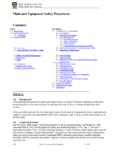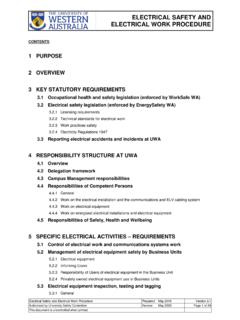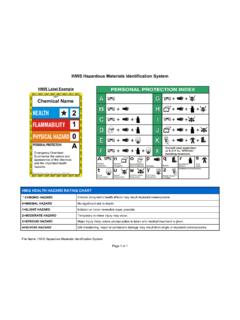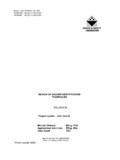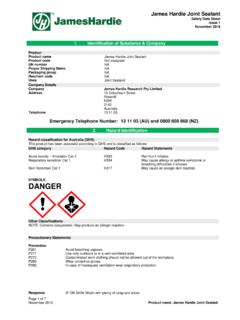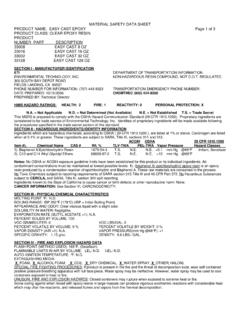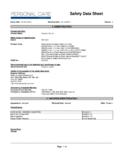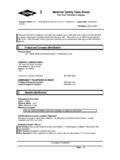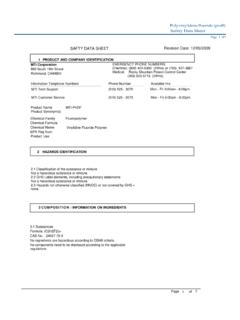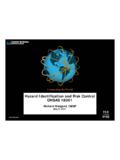Transcription of FIELD WORK HAZARD IDENTIFICATION CHECKLIST
1 FIELD work HAZARD IDENTIFICATION CHECKLIST Published: October 2012 Version Authorised by UWA safety and Health Review: October 2017 Page 1 of 3 This document is uncontrolled when printed - the current version is on the safety and Health website FIELD WORK HAZARD IDENTIFICATION CHECKLIST The hazards listed below should be considered when completing the FIELD Work Plan and Risk Assessment. POTENTIAL hazards / THINGS TO CONSIDER FIELD Work activities at site Tides and Weather tide data meteorology bureau forecasts urban survey bushwalking traverse on foot abseiling radio broadcasts rock/tree climbing Urban working at height urban dogs sample collecting hostile or violent persons underground work/caving diving/snorkelling boating geological sampling wall collapse potential rock chips Chemicals/Hazardous Substances carcinogens, geno toxins (mutagens, teratogens)
2 Sensitising agents Personal corrosive agents sunburn irritants heat stress toxic substances (poisons) cold stress solvents manual handling, lifting MSDS available Slips and trips Overseas FIELD Work mental stress disease personal security and safety allergies vaccinations political climate local authorities/approvals Fauna & Flora sting animals (terrestrial/marine) Mechanical hazards dangerous marine animals vehicles stock (cattle etc.) machinery/moving equipment snakes vibration bats (vaccinations) pressure equipment spiders, ticks, leeches etc.
3 Generation of dust allergens Radiation hazards handling of small animals sealed/unsealed sources ionizing radiation handling of large animals laser harmful plant contact (sap, stinging hairs etc.) radiofrequency Camp Site Fire and Explosion terrain flammable substances falling tree branches explosives flash flooding Thermal hazards safe from wildlife/stock cryogenic fluids safe from vehicles hypothermia secure from theft heatstroke harassment, hostile persons Electrical Transport high voltage equipment vehicles 240v electrical equipment boats Other aircraft specify _____ FIELD work HAZARD IDENTIFICATION CHECKLIST Published: October 2012 Version Authorised by UWA safety and Health Review.
4 October 2017 Page 2 of 3 This document is uncontrolled when printed - the current version is on the safety and Health website The following items should be considered when planning FIELD Work. FIELD Work Party size composition novice/experienced fitness medical conditions Personal protection gloves goggles face masks respirator harness hard hat Clothing sun hat winter clothing (all year) trousers/overalls appropriate footwear high visibility clothing Transport driver licensing driver training Navigation route selection location determination direction determination Etiquette requirements bush etiquette/environment collecting permits permission to enter private land Communication between participants with locals with supervisor with the University radio/satellite phone with Emergency Services Camp requirements potable water and food cooking facilities LP gas arrangements
5 Electrical power failures lighting noise privacy accommodation facilities hygiene/ablution arrangements smoking/alcohol ground rules Fire Risks extinguisher campfires combustibles First Aid Requirements first aider in the group first aid kit in transport portable first aid kit (for walking trips away from base) additional items required Licensing/Authorities Site specific inductions Flora/fauna collecting National Parks permits Indigenous area access permits Access permits- mine sites Access to private property Radioactive substance licence Poison permits AQIS importation permits (overseas activity)
6 Other Other FIELD work HAZARD IDENTIFICATION CHECKLIST Published: October 2012 Version Authorised by UWA safety and Health Review: October 2017 Page 3 of 3 This document is uncontrolled when printed - the current version is on the safety and Health website HEALTH ADVICE AND VACCINATIONS All staff and students participating in FIELD wok are expected to be up-to-date with the Australian Standard Vaccination Schedule (as per NHMRC guidelines).
7 Additional vaccination may be required for travel within certain parts of Australia, international travel or for specific tasks ( working with animals in some regions). Examples of advice and vaccinations required for travel within Australia are: Hepatitis B vaccination for persons working with human blood or tissue; Tetanus vaccination (especially important for persons working with animals or likely to sustain wounds contaminated by soil); Malaria prophylaxis; Mosquito avoidance measures and equipment to avoid dengue fever in far north Queensland and Ross River virus in Northern and Western Australia; Rabies vaccination for the handlers of flying foxes/bats to protect against Lyssavirus which is closely related to the rabies virus.
8 Hepatitis A vaccination for persons handling non-toilet trained infants and toddlers or working with sewage; Japanese encephalitis vaccination should be considered for those engaged in prolonged visits to villages on the outer islands of Torres Strait; Tuberculosis. An example of possible vaccination and medical advice requirements for a FIELD trip to Indonesia is as follows: Counselling regarding mosquito avoidance bite avoidance (to reduce risk of contracting malaria and dengue fever) and the use of anti-malarial medication; Hepatitis A vaccination; Hepatitis B vaccination; Typhoid vaccination; Polio vaccination (oral Sabin); Tuberculosis (only for lengthy stays, certain activities and more important for children than adults); Advice regarding ingestion of safe food and water to prevent diarrhoeal disease including cholera.
9 Review routine vaccination status for tetanus, rubella, measles and mumps. HIGH RISK FIELD WORK ACTIVITIES High risk FIELD work activities require that participants have specific qualifications or skills including:- Boating Diving; Snorkelling; Bushwalking; Cliff walking; Climbing; Use of high voltage equipment; Tractor driving; Off-road 4 wheel driving; Farm work. The University s insurance records show that the major proportion of rural vehicle accidents arise from inexperienced when driving on gravel roads. FIELD work supervisors are strongly advised to ensure that FIELD work participants who will drive on gravel roads have been to an advanced driver training course which has specific emphasis on gravel road driving safety .
10 The RAC web site has helpful information at - search - in the publication RAC Guide to Safe Country Driving . FIELD Work supervisors should ensure that participants meet the minimum skill, experience and qualification requirements for such FIELD work activities prior to commencement of the FIELD work. The FIELD Work Plan should require that certified copies of mandatory qualifications and training be provided by FIELD work participants and held on the staff file.

